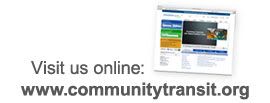Riders love Swift, especially on the weekend!
This week marks the sixth anniversary of Swift bus rapid transit in Snohomish County. The state’s first BRT line has become the cornerstone of Community Transit's bus system, carrying about 5,500 riders each weekday and more than 1.5 million a year. One in six of all Community Transit riders, or about 16 percent of the agency’s ridership is on Swift.
The state’s first BRT line has become the cornerstone of Community Transit's bus system, carrying about 5,500 riders each weekday and more than 1.5 million a year. One in six of all Community Transit riders, or about 16 percent of the agency’s ridership is on Swift.But on weekends, ah, on weekends these numbers are much more impressive!
Nearly 3,800 riders take Swift every Saturday, which is 30 percent of all riders. With Sunday service restored, there are about 2,800 riders boarding Swift every Sunday, or 33 percent of all riders.
The fact is that Swift has proven to be a very convenient way to get around. Pretty good for a six year old! And soon, Swift will have a baby brother (or sister – we won’t know until 2018).
When the next Swift line is up and running, we will have an established BRT network in Snohomish County. With a convenient transfer point at Highway 99 and Airport Road, there will be fast, frequent service across a major part of the county.
Before long, a whole Swift family will be serving the entire county. A third line is already in the conceptual stage to connect with Link light rail at the Lynnwood Transit Center. Our long-range plan calls for eventual Swift service north to Smokey Point and east to Highway 9.
In coming weeks, all Swift buses will get a new decal reminding us of what’s to come. The decal will say, “We’re building a network of Swift lines with fast, easy connections.”
 For now, there is one more improvement to the original Swift line coming soon. The new College Station at 204th Street will provide more convenient southbound access to Edmonds Community College. Construction of this final station on the first Swift line is underway and it will be open when students return from the holiday break.
For now, there is one more improvement to the original Swift line coming soon. The new College Station at 204th Street will provide more convenient southbound access to Edmonds Community College. Construction of this final station on the first Swift line is underway and it will be open when students return from the holiday break.Happy anniversary, Swift!

















